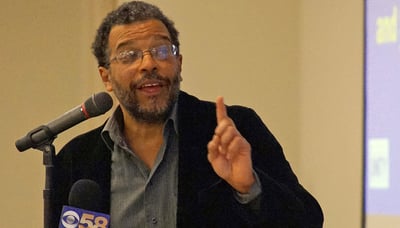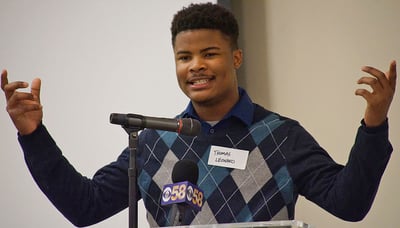
Last week, I was honored to participate in Safe MKE, a half-day seminar on violence in Milwaukee. Joined by a diverse array of health, community, business, advocacy, criminal justice and governmental leaders, I was encouraged by the turnout and inspired by everyone’s passion.
Throughout the morning, there were so many captivating stories and ideas shared by inspiring individuals. One quote in particular has stuck me, though. It was from George W. Albee, a clinical psychologist who pioneered the idea that mental illness is caused by social and environmental factors. He said, “No epidemic has ever been resolved by paying attention to the treatment of the affected individual.”
 Howard Pinderhughes, an associate professor of social and behavioral sciences at the University of California – San Francisco and a board member of the Prevention Institute, summarized this quote by saying, “We cannot arrest our way out of this problem.” That simple phrasing really struck with me. As I thought about it more, I took it a step further and applied it to our work at Children’s Wisconsin: We cannot stitch our way out of this problem, either.
Howard Pinderhughes, an associate professor of social and behavioral sciences at the University of California – San Francisco and a board member of the Prevention Institute, summarized this quote by saying, “We cannot arrest our way out of this problem.” That simple phrasing really struck with me. As I thought about it more, I took it a step further and applied it to our work at Children’s Wisconsin: We cannot stitch our way out of this problem, either.Getting at the root cause of violence
Last year, Children’s Wisconsin treated more than 50 children with gunshot wounds. The youngest was less than a year old. Each year, our emergency department treats more than 500 assault cases and our seven Child Advocacy Centers see 7,000 incidents of child abuse across the entire state. It’s unconscionable.
At Children’s Wisconsin, we understand it is not enough to simply be exceedingly good at treating the immediate result of the violence — the gunshot or stab wound, the broken bones and bruises of domestic violence, the fear and physiological anguish. We treat impacted children with all the science, technology and compassion that we can bring to bear — but that will not get at the root cause of the issue.
Our team understands that the medical portion is just a small sliver of that child’s whole violence experience. It’s our vision for Wisconsin’s kids to be the healthiest in the nation, and for us to reach that goal we must be the place that keeps kids healthy in the first place.

Our work in the community
For every one of those thousands of kids we see at Children’s Wisconsin, there is a ripple effect — the siblings who saw their brother or sister get shot, the family that is traumatized and the neighbors who become even more isolated. Violence is a disease — an epidemic — and must be treated as such. Combating violence will take the commitment and collaboration of everyone who cares about kids and about our community.
A great example of this sort of work has been taking place in our Emergency Department since January 2015. The concept of this pilot program, which is a collaboration with the Milwaukee Police Department, West Allis Police Department and the Medical College of Wisconsin’s Injury Research Center, is shockingly simple but the effects could have major implications. Whenever a kid comes into our emergency department with an injury caused by an act of violence, we ask that child and family when and where the incident happened. No other Children’s Wisconsin emergency department asks those two simple questions. We then take that data, plot it on a map, and overlap it with police data. From there, patterns of violence can be detected and — with some preemptive, targeted, community-wide action — prevented.
For example, in the past year, we saw 10 injuries within a 500-foot area. We examined that location and found it contained four bars and a liquor store. It’s no secret that drugs and alcohol are common contributing factors to acts of violence. We also learned that 40 percent of all of the assaults happened in or around schools, which breaks my heart. Schools must be a safe space for children. Now armed with this knowledge, the community and law enforcement can begin to devise and implement targeted plans to prevent these incidents from happening in the first place.
This program is based off The Cardiff Model. Cardiff is the largest city in and capital of Wales in the United Kingdom. With a metro population of about 1.1 million, it’s roughly comparable to Milwaukee in size. The Cardiff Department of Health launched their emergency department program in 2002. By 2004, they had experienced a reduction of violence related emergency department visits by 40 percent.
This type of work builds off of other violence prevention initiatives Children’s Wisconsin has been engaged in for decades. We have community navigators and school nurses who provide direct and immediate social, emotional and medical support so that individuals and families don’t have to resort to violence to address problems. Project Ujima identifies children who have been victims of assault and wraps them and their families in support services to address the social and emotional impact of violence. We also know that toxic stress causes chemical changes in the brain and that young victims of violence are far more likely to resort to violence in adulthood. It’s a vicious cycle the community has to collectively work together to stop.
These are just a few examples of going upstream, of learning from what works in other cities around the country and globe, and of collaborating to help identify the root causes of violence to help keep kids, families and communities safe. While the Safe MKE event was certainly a success, it’s merely the first step in what will be a long journey — a journey that we must see through to the end.
On behalf of everyone at Children’s Wisconsin, I want to thank all the community partners who have committed to work to end violence in Milwaukee and who helped put Safe MKE together, including the Greater Milwaukee Committee, Northwestern Mutual, the City of Milwaukee Health Department Office of Violence Prevention, the United Way of Greater Milwaukee and Waukesha County, the Prevention Institute, and 371 Productions.
Children's Wisconsin Resources

Written by
Michael Levas
, MD
Emergency Medicine



